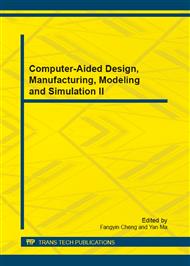[1]
World Health organization (WHO), http: /www. who. int.
Google Scholar
[2]
T. G. Zimmerman. Personal area networks: near-field intrabody communication. IBM systems Journal, 1996, vol. 35, no. 3 & 4, pp.609-617.
DOI: 10.1147/sj.353.0609
Google Scholar
[3]
Shuo Xiao, Ashay Dhamdhere, Vijay Sivaraman, and Alison Burdett. Transmission Power Control in Body Area Sensor Networks for Healthcare Monitoring. IEEE JOURNAL ON SELECTED AREAS IN COMMUNICATIONS, VOL. 27, NO. 1, JANUARY (2009).
DOI: 10.1109/jsac.2009.090105
Google Scholar
[4]
Sana Ullah, Henry Higgins, Bin Shen and Kyung Sup Kwak. On the implant communication and MAC protocols for WBAN. International Journal of Communication Systems, Int. J. Commun. Syst. Wiley InterScience. (2010).
DOI: 10.1002/dac.1100
Google Scholar
[5]
Sana Ullah, Pervez Khan, Niamat Ullah, Shahnaz Saleem, Henry Higgins, and Kyung Sup Kwak. A Review of Wireless Body Area Networks for Medical Applications. ArXiv: 1001. 0831v3 [cs. NI] 3 Aug (2010).
DOI: 10.4236/ijcns.2009.28093
Google Scholar
[6]
Harri Viittala, Matti Hämäläinen, Jari Iinatti, Attaphongse Taparugssanagorn. Different experimental WBAN channel models and IEEE802. 15. 6 models: comparison and effects. 2nd International Symposium on Applied Sciences in Biomedical and Communication Technologies (ISABEL 2009), Bratislava, Slovakia, Nov. 24-27, (2009).
DOI: 10.1109/isabel.2009.5373626
Google Scholar
[7]
John Hagedorn, Judith Terrill, Wenbin Yang, Kamran Sayrafian, Kamya Yazdandoost, Ryuji Kohno. A Statistical Path Loss Model for MICS. IEEE 802. 15-08-0519-01-0006, September (2008).
Google Scholar
[8]
Anders J Johansson, http: /citeseerx. ist. psu. edu/viewdoc/summary?doi=10. 1. 1. 7. 5752.
Google Scholar
[9]
IEEE 802. 15 WPAN Task Group 6 (TG6) Body Area Networks. IEEE P802. 15-08-0780-10-0006 [Online]. Available: http: /www. ieee802. org/15/pub/TG6. html.
Google Scholar
[10]
FCC MICS Bands, http: /wireless. fcc. gov/services/index. htm?job=service_home&id=medical_implant.
Google Scholar
[11]
Huseyin S. Savci, Ahmet Sula, Zheng Wang, Numan S. Dogan, and Ercument Arvas, MICS transceivers: regulatory standards and applications, in IEEE SoutheastCon Proceedings, April 2005, p.179–182.
DOI: 10.1109/secon.2005.1423241
Google Scholar
[12]
H.B. Li, J. Schwoerer, Y.M. Yoon, J. Farserotu, W. Yang, K. Sayrafian, D. Miniutti, D. Lewis, A. Gowans, and J. Moss, IEEE 802. 15. 6 Regulation Subcommittee Report, IEEE 802. 15 Working Group Document, IEEE P802. 15-08-0034-11-0006, Sept. (2008).
Google Scholar
[13]
F. Molisch et al., IEEE 802. 15. 4a channel model-final report, IEEE P802. 15 Working Group for Wireless Personal Area Networks (WPANs) (IEEE 802. 15-04-0662-01-04a, Sept. 2004).
Google Scholar
[14]
Karacolak T, Cooper R, Topsakal E, Electrical Properties of Rat Skin and Design of Implantable Antennas for Medical Wireless Telemetry, IEEE Transactions on Antennas and Propagation, Vol 57, No 9, Sept. 2009, pp.2806-2812.
DOI: 10.1109/tap.2009.2027197
Google Scholar


